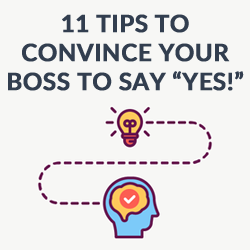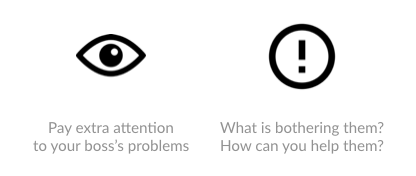 What if you could actually convince your boss?
What if you could actually convince your boss?
I know…
From playing the game of politics to slow decision-making to lack of time, we often face many obstacles at work. ?
It can be hard.
So here are 11 effective tips to persuade your boss to make change happen.
People who’ve used these tips got their boss to implement new ideas and made an impact at work. This is a guide to help you make innovation happen too.
Warning: you are NOT going to find anything about being a bootlicker (dull) or working hard (boring) here.
Now that you’re ready:
Let’s explore each of these 11 ways to convince your boss to try new things.
1. Frame your suggestion to match the goals of your boss
If you get this first tip right, you’ve got 80% of the job done.
As humans, we tend to think about ourselves first. But this is not how you can convince someone.
Take this approach instead:
Frame your suggestions in terms of how it can help your boss.

Here’s what matters to your boss: convincing her own boss, improving how your team performs, generating more revenue, or simply making your boss look good in front of everyone.
For this you need two things:
- Understand where your boss wants to be—the goals;
- Find how your suggestion can help your boss get there—the way.
Here’s an example about convincing your boss to work from home:
Your boss may not care about the fact that it will make your commute less stressful. But she will care if you explain that you can start working an hour earlier.. or that you’ll get work done faster because you’ll be less interrupted.
Put yourself in your boss’s shoes.
As a side note: I’m using the term “boss” to keep it simple. I should say: “decision-maker“. In many cases, the person you need to convince is not your boss but a team member or a colleague from another function.
They want to know how your ideas can help them.
What are their goals? What will get them look good in front of their own bosses? What do they need to get promoted?
2. Pay extra attention to your boss’s problems
It is natural to think first about solving your own problems. “If I could automate this task, it would make my life so much easier.”
New ideas often come from problems we face every day at work.
But here’s the thing:
Your boss cares more about making their lives easier than yours. For example, instead of presenting an idea as a way to make your life easier, frame it as a way to make yourself more productive.

The more you understand what your boss wants, the more chances you have to persuade him.
This is an example of emotional intelligence.

You must genuinely care about your boss’s problems. Read How to Win Friends and Influence People to understand what I mean. (It is such a great book.)
Stop considering your problems first. Look at the world from the perspective of your bosses.
Ask yourself:
What is bothering them? What do they have in mind? How can you solve their problems?
3. Build the reputation for being a great performer
Any boss would trust more a great performer than the average employees.
This is normal:
Heroes get praise and attention.
In an organisation, what I call the “hero effect” is similar to how brands impact consumers.
Your personal brand—i.e. reputation—is the result of how people perceive you at work.

The “hero effect” leads people to value you, your work, and your opinion. If something goes wrong, you’ll earn the benefit of the doubt.
In his great book Power (recommended read), Jeffrey Pfeffer highlights with sarcasm that, as long as you keep your boss happy, performance doesn’t matter that much:
“Make sure that those in power notice the good work that you do, remember you, and think well of you because you make them feel good about themselves. It is performance, coupled with political skill, that will help you to rise.”
Getting noticed is primordial.
The more you see and hear about it, the more you trust it.
And the best way to get your boss’s attention is to pay attention to what your boss cares about.
If you are looking for inspiration, besides reading Power, I also recommend that you read Tribes. In this book about leadership, Seth Godin tells stories of people who have had a significant impact within and beyond their organization.
Keep in mind:
Bosses are more likely to consider ideas from those they see as the best in their team. It depends on two things:
1. The quality of your work—what you do;
2. How your boss sees the results—what people say about you.
Building a good reputation takes time. Be patient. Match the size of your suggestion to the quality of your reputation.
4. Take advantage of the FOMO
Most organisations are (very) conservative…
People don’t want to risk their reputation. They do not like change and avoid any bold decisions. So they love killing new ideas.
Here’s what you can do:
Create a sense of urgency. Comparing is a great tool for that. Mentioning what competitors do can trigger a fear of missing out (FOMO).
FOMO is a scientifically proven phenomenon. Dr Andrew K. Przybylski, a research fellow at Oxford University, defines it this way:
“A pervasive apprehension that others might be having rewarding experiences from which one is absent.”
You can make a strong case by establishing that some competitors have implemented a new idea with success. (Nobody wants to stay behind the competition.)
You can also use an analogy.
Tell the stories of organisations in other industries. It can help your boss understand how this would work in your own company.
Mentioning what other organisations do can support your ideas. Bonus: you’ll be more likely to convince your boss if you talk about companies she respects.
5. Look for inspiration
It’s easy to get stuck in our own thinking.
In this case, what you need is external stimuli.
One way of getting inspiration is to read books. It gives you new ways of approaching things. And most books also share interesting examples you can share with your boss.
Here’s an example:
Let’s say you want to influence your company’s recruitment process. You could get some inspiration from books about Google and how the HR team uses data to make decisions.
Your boss doesn’t have to read these books.
You can just create a one-page summary and share it with your team, for example.
I’m talking about books. But actually, any format works. Search for blog articles, scientific publications, podcasts, or YouTube videos.
Searching for a good book? Have a look at my reading list.
6. Build a coalition
Build an internal network.
If you’re not alone to suggest an idea, it will sound more compelling.
Think about how your idea can also help your colleagues—how it can be useful to them. If possible, try the idea at a small scale with them. If you want to roll out new software, you could invite them to try it with you.
When should you talk about your idea?
The best moment is over a cup of coffee in the kitchen or corridor. I find that scheduling meetings with colleagues to talk about a new idea can be too formal, especially at the beginning.
Once you’ve found a few people interested in your idea, your boss will be more likely to agree on trying it.
Try to get your colleagues involved.
You may even want to let one of them lead the initiative, instead of you
7. Use data to tell a story
We say “numbers don’t lie”.
But they can be difficult to understand.
For example, the human mind can’t get the concept of billions of dollars. But once you make it visual, it’s easier to understand.
Here’s a visualisation of things that were worth billions of dollars in 2009:

You can now see the size of the Beijing Olympics Games 2008 compared to the funding of NASA.
Stories are more convincing than numbers.
Data visualisation helps us see new patterns.
It’s a visual story changes how we see things—i.e. how your boss makes decisions.
The word “data” can be scary. Fortunately, you don’t need obscure numbers to make people see things differently.
Here’s an example:
Look at how the blog Wait But Why changes how you may look at life. It simply shows the life of a typical American (data available to everyone).

It’s simple. But it can really help you think about how you spend your life.
But where can I find data?
We’re lucky. Finding the data is easy.
You can find a lot of data in secondary research. You can also have a look at your marketing tools—e.g. online analytics and CRM. Have a chat with the accounting department and use financial reports.
These sources of data can already give you a lot.
If your idea involved creating a product, you can also leverage customers interviews. (Read my reflections on how to ask better questions in a customer interview). For example, interview several potential customers and record their reaction in audio or video. You can be able to visualise their reactions plotting quotes on a graph for example.
There are tons of things you can do to convince people using data visualisation.
8. Derisk the decision for your boss
Low risk, high reward.
These are the characteristics of a decision that is easy to make.
The reward is how helpful your idea is to your boss: Does it help her achieve her goals? Does it solve one of her problems? Does it make her look good inside and outside the company?
The risk involves costs, the likelihood of failure, and the consequences of failing.
The lower the risk, the more convincing your idea will be. So find ways to lower how risky the idea is. One way of achieving this is by experimenting.
9. Experiment with your idea
If the risk is high, your boss will struggle to make a quick decision.
A solution is to go step-by-step:
A small-scale experiment will help you test your idea, without costing too much.
It could be testing a new feature for your product using a prototype.
It could be experimenting with a new way of working for a couple of weeks.
…
What’s important:
1. You need to define what success looks like;
2. You need a way to measure the result of your experiment.
Experimenting makes the chat with your boss more concrete. You’re getting real data to prove your case. It will help you make your boss more confident that your idea can work.
Bonus: You can use data visualisation to tell a story with the result of your experiment.
10. Know how to pitch it to your boss
The infamous pitch.
It’s the moment you get to persuade your boss to say “yes”.
How should you do it?
You need to know what your boss likes. Should you discuss it informally while having a coffee? Should you book a meeting with other stakeholders? Should you first send a one-pager to present the idea? It depends on what your boss is used to.
Observe how other people pitch your boss and what tactics seem to work best.
My rule of thumbs is to keep it low profile at the beginning. It makes things less scary (and more human). Obviously, it depends on your boss.
If you want to become better at pitching:
1. Read this article about how startups pitch investors (a lot of good examples);
2. Pick a book about negotiation. They teach you how to persuade other people. Pitch Anything by Oren Klaff is a good one.
11. Make sure people know about it
Getting your boss to say “yes” is just the beginning.
It’s often when an idea becomes a project.
A project needs a leader—someone who is accountable for it. A project creates results that you monitor overtime.
And managing a new project requires a lot of effort. I often see my clients, who are running a new project, doing it in their spare time.
New ideas can lead you in many different spaces. It could be a project about improving a way of doing things, launching a new feature for your product, or creating a new subsidiary. Some are more complex than others. But they all have one thing in common:
You need to make sure people know about it.
It’s your role to advertise the project internally (and externally when relevant). It’s your role to get people excited about it. It’s your role to make sure people get involved if you need them to do so.
Once your boss has agreed to give it a try, you have to focus on two things:
1. Do everything you can to make sure that it will work;
2. Get people involved and make sure everyone knows about the new project.
It’s now your turn to persuade your boss to try new ideas
If you liked this article, you will like my new book on how to be a great manager.
In The Inspiring Team Lead, I give you all my best tips to lead and guide your team with success. There’s also a chapter dedicated to how best manage up.
Have a look at The Inspiring Team Lead.
